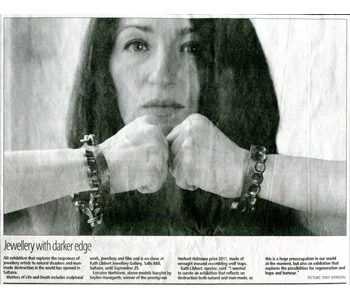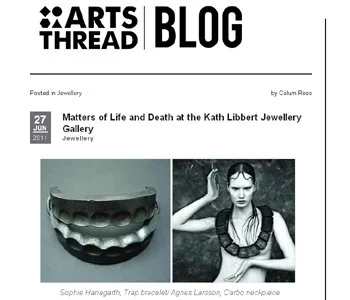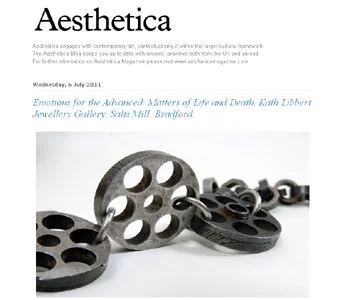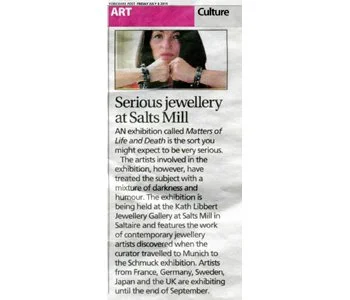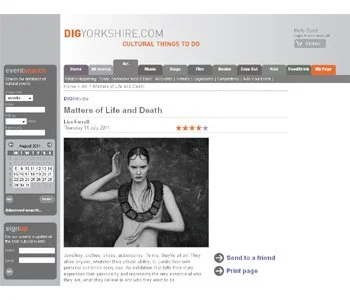Matters of Life & Death
7th July - 25th Sept 2011
Yorkshire Post, July 8th 2011
YORKSHIRE POST
Friday July 8th, 2011
Jewellery with darker edge
AN exhibition that explores the responses of jewellery artists to natural disasters and manmade destruction in the world has opened in Saltaire.
Matters of Life and Death includes sculptural work, jewellery and film and is on show at Kath Libbert Jewellery Gallery, Salts Mill, Saltaire, until September 25.
Lorraine Hurlstone, above models bangles by Sophie Hanagarth, winner of the prestigious Herbert Hofmann prize 2011, made of wrought ironand resembling wolf traps.
Kath Libbert, curator, said: "I wanted to curate an exhibition that reflects on destruction both natural and man-made, as this is a huge preoccupation in our world at the moment but also an exhibition that explores the possibilities for regeneration and hope and humour."
Picture: Tony Johnson
Arts Thread, June 27th 2011
ARTS THREAD
27th June, 2011
Matters of Life and Death at the Kath Libbert Jewellery Gallery
Matters of Life and Death, an exhibition featuring the work of nine international jewellery artists will be opening at the Kath Libbert Jewellery Gallery in the Salts Mill, Bradford on the 7th of July.
Each artist will exhibit a piece designed in response to the theme of natural disasters and man-made destruction. The exhibition is set to provoke and inspire visitors with work ranging from sculptural pieces to film and jewellery.
The creatives selected for the exhibition include Herbert Hofmann prize winner Sophie Hanagarth, Agness Larsson and her unusual carbon and horse hair necklaces and Bernhard Lehner who will be displaying pieces created from deconstructed weapons.
Visitors are actively encouraged to interact with the pieces on display and are asked to try on the jewellery and document their emotional reaction to the work on the ‘Chain of Thought’ installation.
Matters of Life and Death is open from July 07 to September 25 at the Kath Libbert Jewellery Gallery, Salts Mill, Saltaire, Bradford BD18 3LA
Aesthetica, July 6th 2011
Aesthetica
Wednesday July 6th, 2011
Emotions for the Advanced: Matters of Life and Death, Kath Libbert Jewellery Gallery, Salts Mill, Bradford.
Kath Libbert Jewellery Gallery specializes in contemporary jewellery, silver and metalsmithing, showcasing diverse collections by over 70 renowned designers and emerging talents from Britain and abroad. Each year, Kath Libbert travels to Schmuck, the definitive jewellery event in Munich where contemporary art jewellers from around the world exhibit their work to an international audience of gallerists and collectors.Kath uses the experience of Schmuck to inspire her annual summer show, meeting jewellers, and identifying themes. This July, Matters of Life and Death opens at Salts Mill, an exhibition that explores the responses of nine international jewellery artists to the proliferation of natural disasters and man-made destruction in our world. We caught up with Kath to find out what goes on behind the scenes.
Do you go to Schmuck with a theme in mind?
This year I travelled to Munich thinking about humour. I felt that I’d be looking for work that expressed humour. When I got there and explored the various exhibitions however, I discovered other themes that struck me more acutely. I was particularly struck by themes of darkness and found that many jewellers had created collections that dealt with issues of darkness and destruction. This was a complete contrast to last year’s show when I came back inspired by all things floral and went on to curate the exhibition IntoFlora!
Why do you think that these themes are emerging?
Art jewellery is a form that has a particular ability to express the Zeitgeist. In addition it has an added currency and potency because of its connection to the human body. Our concerns about both natural and man-made destruction are reflected in the work that many jewellers are currently making.
How difficult is it to maintain your vision when visiting such a huge exhibition as Schmuck?
It’s important to remain open minded and yet to maintain vision – there are so many beautiful pieces that aren’t necessarily relevant to the theme that is emerging. But I can store them up to use as inspiration for later shows. There are a myriad of other possibilities!
Why not just go to the show, pick out your favourite work and exhibit it all together?
The way I like to work is to find a way of unifying the experience. Curating an exhibition on a particular theme helps greatly with the display and of course also with how we promote the exhibition. As the work we exhibit at the gallery may often be made of unfamiliar or surprising materials, working thematically can give visitors a route into the work, adding interest to what is presented visually. Having a curatorial theme greatly helps highlight what has gone into the making of the work and the themes behind it.
So what will you be bringing from Schmuck to Kath Libbert Jewellery Gallery in 2011?
The exhibition that has emerged is called Matters of Life and Death, about big, elemental themes of life and death, creation and destruction with an injection of light-hearted humour to provide contrast or light relief. This reflects the current concerns I mentioned earlier.
Which jewellers’ work struck you in particular?
We will be exhibiting work by Sophie Hanagarth, who is this year’s winner of the Herbert Hofmann prize, the world’s most prestigious contemporary jewellery award. Her Trap collection includes wrought iron bracelets that resemble wolf traps with sharp, articulated claws. Hanagarth calls them jaws, dentures or mouths worn on the arm, and I love the brutality and sensuality of that idea. Some of our collectors are already very excited about Sophie Hanagarth’s work. I was also very struck by Swedish jeweller Agnes Larsson ’s work. She creates super statement dramatic neckpieces from carbon and horsehair that explore areas of life and death, darkness and light, surface and depth, fragility and strength. I really liked Bernhard Lehner’s work – he’s a multimedia artist who makes jewellery which he describes as symbolic disarmament – he deconstructs weapons, literally saws them apart, and then reforms them as pieces of provocative jewellery.
And will we be able to see these jewellers’ work in Matters of Life and Death?
Yes, these three jewellers and also collections of work by Akiko Kurihara, Samantha Queen, Angela O’Keefe and Peter Vermandere.
You have become known for a very original and fun-loving curatorial style. What else will be happening as part of Matters of Life and Death?
Well, we will have an interactive element to the exhibition. Visitors will be invited to be photographed wearing pieces that move, excite or even revolt them and to record their response on our Chain of Thought, an installation that will become an integral part of the exhibition. There will also be two provocative videos on show by renown installation artist Gisbert Stach.
Matters of Life and Death runs from 8 July - 25 September
Yorkshire Post Culture Section, July 8th 2011
YORKSHIRE POST
Culture Section
Friday July 8th, 2011
Serious jewellery at Salts Mill
AN exhibition called Matters of Life and Death is the sort you might expect to be very serious. The artists involved in the exhibition, however, have treated the subject with a mixture of darkness and humour. The exhibition is being held at the Kath Libbert Jewellery Gallery at Salts Mill in Saltaire and features the work of contemporary jewellery artists discovered when the curator travelled to Munich to the Schmuck exhibition. Artists from France, Germany, Sweden, Japan and the UK are exhibiting until the end of September.
LIVING NORTH: the magazine for Yorkshire, High Summer 2011
LIVING NORTH
High Summer , 2011
JUST JEWELS
Matters of Life and Death is an exhibition that explores the responses of nine international jewellery artists to the proliferation of natural disasters and manmade destruction in our world. Including sculptural work, jewellery and film, and curated in a way that makes religious, political, artistic and fashion statements, the exhibition will pose questions about life and death, light and dark, sobriety and humour. As well as a walk on the dark side, there will also be a showcase of energetic, creative and joyful work, that will no doubt inject life into a very deep and meaningful exhibition.
Until 25th September, Kath Libbert Jewellery Gallery, Salts Mill, Bradford, 01274 599790
www. kathlibbertjewellery. co.uk
Crafts Magazine, July 18th 2011
CRAFTS MAGAZINE
July 18th, 2011
Kath Libbert’s annual summer show (7 July – 25 September) features work by nine jewellers who caught her eye at this year’s Schmuck, the big jewellery event held every year in Munich
Called Matters of Life and Death, the main body of the show looks at how jewellers respond to natural disasters and man-made destruction. But Libbert’s allowed a little bit of humour to lighten up this serious theme, showcasing more joyful work by the likes of Lina Petersen and the pun-loving Japanese jeweller Akiko Kurihara. The work is fascinating with some of the overseas makers probably being new to UK audiences and many of them exploring new materials like Agnes Larssen who works with carbon and horse hair. Look out for Sophie Hanagarth’s Trap jewellery, it’s inspired by wolf traps which she translates into ferocious looking bracelets clamping down on human limbs echoing traps or even sets of teeth. The juxtaposition of these painful looking forms with bare human flesh creates an uneasy, yet faintly sensual effect. Bernhard Lehner also opts for a new approach using cut up weapons, including a Spanish Civil War revolver, to make what he calls ‘symbolic disarmament’ jewellery.
Dig Yorkshire, July 14th 2011
DIG YORKSHIRE
July 14th, 2011
Matters of Life and Death
Lisa Farrell
Jewellery, clothes, shoes, accessories. To me, they’re all art. They allow anyone, whatever their artistic ability, to curate their own personal exhibition every day. An exhibition that tells their story, expresses their personality and represents the very essence of who they are, what they believe in and who they want to be.
Matters of Life and Death really spoke to me for this reason. Curated by Kath Libbert at her jewellery gallery in the beautiful Salts Mill, the exhibition explores the personal responses of nine international jewellery artists to themes of man-made destruction, natural disasters, regeneration and hope. Highly interactive and provocative, each artist poses a series of multi-layered questions, stories, paradoxes and statements through the medium of their jewellery.
The provocation I felt was immediate. After being in the gallery for ten minutes, Sophie Hanagarth’s wrought iron bracelet, which resembles a ferocious wolf trap, was clasped upon my hand. The sensation of seeing and feeling my hand devoured by such a brutal, yet beautifully crafted device was overwhelmingly paradoxical – is it ok to enjoy wearing something so fiercely evocative of pain and violence?
Bernhard Lehner’s sword necklace is another thought-provoking piece. A violent weapon originally created for harm and destruction has been transformed into a striking body adornment by being sawn into small pieces. Even the method of transformation is similar to the way the original weapon was used to cause harm. For me, this presented a challenging question about transformation and redemption. Can someone, or something ‘bad’, ever be totally transformed into something completely different (and ‘good’), if they are ultimately the same person, or consist of the same original elements? It’s a question I can’t answer, but I relished the opportunity Lehner’s jewellery gave me to ponder it.
As well as jewellery dealing with darker themes, the exhibition explores more playful and optimistic ideas. Samantha Queen’s post-apocalyptic tree brooches are wonderful. My favourite was a colourful, jauntily shaped tree trunk adorned in a painstakingly intricate mosaic pattern. The foliage itself is like a little window, covered by tiny glass shards which can be shaken to reveal a gorgeously hopeful vision of an unfamiliar, yet beautiful new world, born out of apocalyptic chaos.
Visitors to Matters of Life and Death are invited to be photographed wearing the piece that moved, excited or revolted them the most, and to record their personal response on a ‘Chain of Thought’, which aims to be the focal point of the exhibition. Unable to resist a chance to try on the jewellery, I was drawn towards a statement white necklace created by Angela O’Keefe, which formed part of a set of dazzling jewellery where all the pieces were made using salt. I was completely enamoured with the premise that something so exquisite could be made from something so natural and completely fundamental to our existence. The absolute epitome of natural beauty.
An exhibition that provokes and delights, Matters of Life and Death at the pint-size Kath Libbert Jewellery Gallery proves that very good things do indeed come in very small, and beautiful, packages.
Image: Agnes Larsson neckpiece in Carbon and Horsehair from her series 'Carbo'.
FINDINGS, Issue 53 Autumn 2011
FINDINGS
The Magazine of the Association of Compemporary Jewellery.
Issue 53 Autumn 2011
MATTERS OF LIFE AND DEATH
Kath Libbert Jewellery, Saltaire. 7 July-25 September
Reviewed by Elizabeth Moignard
I came to see this exhibition late in its run, by which time it had been seen by a lot of people, many of whom left photographs of themselves wearing a chosen item from the show, and the ideas it generated, in a Chain of Thought, which formed an important part of the exhibition alongside nine makers reflecting on crucial issues, challenging, enlivening and a pause for reflection.
Can jewellery be used effectively as a message-board by the maker? What happens when the piece is worn, if it is conventionally wearable rather than using a standard form to do something else, as Agnes Larsson's 'Carbo Neckpiece' uses carbon and horsehair to explore the permeable interface between life and death, via natural materials which have a presence in both states of being.
How does jewellery work as a statement medium for the maker, wearer and the viewer? What does each intend by their interaction with a piece? I would use Peter Vermandere's quirky Baroque Pearl Men deliberately to see what I get from the viewer - laughter, irritation, a comment on their inappropriate nature as an ornament? Pearls are organic, subject to decay by natural or interventionist activity: we might view Gisbert Stach's installation involving the overgrowth of a pearl necklace by a tree as a commentary not only on the connections between beauty and starvation, but also on the nature of ascribed value, of the interface between people, objects and time, and like many of his pieces and installations, on ephemeraliry and destruction. Is a title as important to the communication of the message as the piece itself? The work of Akiko Kurihara plays with visual and verbal puns and cross-references: her 'Faces' necklace takes the pearl necklace symbolism in another direction by giving it painted facial expressions, and is probably the example to which the title actually adds least.
Bernhard Lehner's 'Belt made from a Colt revolver used in the Spanish Civil war' is a product of his desire to create art to be touched, worn, and displayed on the body. The observer may recognise its elegant components as sections of a gun magazine, and view it as a positive move to create a beautiful object for the living out of an icon of the human killer-instinct. Iron and steel remain key metals in our lives; equally, they involve enormous environmental destruction in extraction, smelting, and onward use, often for further ruinous activity. Sophie Hanagarth’s 'Trap' braceletsare an interesting fusion of that theme with several others - they have the claws and teeth which are the weapons of an animal which may defend its own patch by attack on others, including humans.
The work which sits at the optimistic end of the spectrum of the show is probably the work that the wearing collector would actually be willing to display on themselves in the course of a normal day. Angela O'Keeffe's salt pieces foreground an essential element of life itself, but they are wearable as examples of their particular format — the 'Fading Light' necklace, with its labradorite collar and salt-crystal frontispiece, has a subtle colour range which could go with lots of different types of clothing, and many skin-colours. How far is the visibility and communication power of a piece linked to its form: does it have to be visually or aesthetically
unconventional to get a message across? Looking at Samantha Queen's 'KonaTree', I hope not. Her colourful plant forms are interpreted in mixes of materials which reflect on our potential power to reconstitute, conserve and repair ourselves and our damaged world through re-cycling and juxtaposition of precious and disposable, if damaging, substances. Equally, Lina Peterson's pieces are an exciting combination of surprising materials, often treated in experimental ways; the new 'Chinese Whispers' series comments wittily on organic growth and changing form.
'Life and death, light and dark, sobriety and humour' - an eloquent and moving reflection on the exhibition title by nine artists and its curator, and equally, a valuable contribution to the ongoing debate about the nature of jewellery as a communication medium.
Craft Arts International, Issue 83, 2011
CRAFT ARTS
INTERNATIONAL
Issue 83, 2011
MATTERS OF LIFE AND DEATH
Kath Libbert Jewellery Gallery, Salts Mill, Saltaire, UK, 7 July -25 September, 2011.
THIS exhibition explored the responses of nine international jewellery artists to the proliferation of natural disasters and manmade destruction in our world. It included sculptural work, jewellery and film, curated in a way that makes religious, political, artistic and fashion statements about dualities such as life and death, light and dark, sobriety and humour.
Visitors were not only confronted by the striking jewellery but were also induced into wondering how it would feel to have a wolf trap clasped around their wrist? Sophie Hanagarth, this year's winner of the Herbert Hofmann prize, the world's most prestigious contemporary jewellery award, showed Trap, wrought iron bracelets that resemble wolf traps with sharp, articulated claws. Says Hanagarth, 'They're jaws, dentures or mouths worn on the arm. They absorb us, eat us or suck us. By the mere act of putting on these bracelets, our hand is gobbled down, devoured, an extremity of the human body is captured.' The pieces are brutally beautiful, surprisingly sensual and extremely wearable!
'Do you dare wear Carbon and Horsehair?' asked Agnes Larsson who combines these unlikely yet elemental materials to create very dramatic neckpieces. Carbon is a basic material existing in all living things but which we also consider to be dead, burned and charred, while horsehair is a natural material that has connections to the body and life. Larsson says, 'In my work I see opposites like alive and dead, darkness and light, surface and depth, fragility and strength.' Can severed swords become jewels to adorn the body was raised by Bernhard Lehner, who describes his jewellery as 'symbolic disarmament'. He deconstructs weapons and reformed them as pieces of provacative jewellery; instruments of destruction recreated as wearable decoration for the body.
But "Matters of Life and Death" wasn't all about doom and gloom The curator also selected jewellers whose work is energetic, creative and joyful to lift the spirits, such as colourful post apocalyptic mosaic tree brooches by Samantha Queen and vibrant, avant garde work by Lina Peterson that injects a literal ray of sunshine. The exhibition also includes some humorous highlights courtesy of Akiko Kurihara, whose playful punning pieces charm and engage and Peter Vermandere with gargoyle- inspired pearl pins curiously titled Emotions for the Advanced.
Comments curator Kath Libbert, 'I wanted to present an exhibition that reflects on destruction, both natural and man-made, as this is a huge preoccupation in our world at the moment - but also a show that explores the possibilities for regeneration, hope and humour. We invited visitors to be photographed wearing a piece that moved, excited, or revolted them ... and to record their response on an ever growing "chain of thought" which will became an integral part of the "Matters of Life and Death" show.
Since 1996 this leading contemporary jewellery gallery has been set within Salts Mill, home to the world's largest collection of work by David Hockney. Open daily, it specialises solely in contemporary jewellery, silver and metal smithing showcasing diverse collections by over 70 renowned designers and emerging talents from Britain and abroad.
Much of the work on show pushes and blurs the boundaries between fine art, jewellery design and fashion resulting in jewellery that is, perhaps, best described as wearable art. Pieces are often created using a surprising range of diverse materials and techniques.
The gallery organises a number of major exhibitions each year, some of which have been supported by funding from Arts Council England and the Crafts Council in recognition of the important role they play in showcasing the best of British and international talent in Yorkshire and the UK.
Kath Libbert Jewellery Gallery is also well known for its popular Annual Alternative Wedding Show, now in its 10th year. Alongside collections of wedding and engagement jewellery which the gallery have all year round, this show features the newest most distinctive individually designed and handcrafted rings and other bridal jewellery and tiaras. All can be custom made in silver, gold or platinum and set with stones of the client's choice, including stones and gold from existing family heirlooms.
The gallery also offers OwnArt, an interest free loan scheme set up by Arts Council England which enables people to acquire contemporary art/jewellery and pay for it over 10 months.
Salts Mill is a magnificent Victorian textile mill built by Sir Titus Salt in the centre of Saltaire, the "model village" he built to house his community of mill workers. Saltaire, which is surrounded by stunning scenery, was awarded World Heritage Status in 2001.

